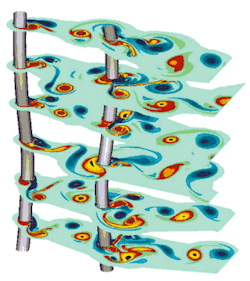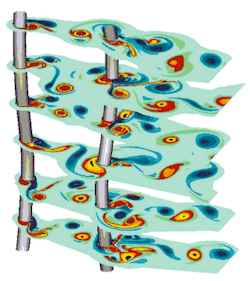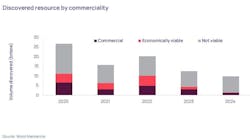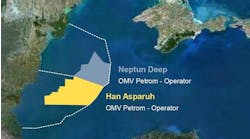2D 1/2 model generated by Deepflow for riser analysis.
Vortex induced vibrations (VIV) have emerged as a significant challenge in riser design as the offshore industry moves into greater water depths, and may require new configurations. The problem is not that they always represent a real threat, but rather that the industry cannot model them with a simple tool and sufficient accuracy.
In deepwater, a riser is always excited by vortices. The amount of energy received by the structure can be decreased in a real environment, compared to an experimental setup, due to various perturbations (currents, waves). In order to assess VIV, various joint industry projects are monitoring in-situ configurations to calibrate models.
Several numerical approaches exist. The most common is the modal approach, such as Deepviv, developed at the Institut Français du Pétrole (IFP). These software packages are validated, versus various experiments, but the results are reliable only within a restrained range of validation (generally vertical risers). Outside these applications, research is still ongoing. A wave approach is also being developed, but cannot yet be used in most cases.
A more precise approach is to combine the structural methods with a less crude model of the fluid by using a van der Pol oscillator, which takes into account the main fluctuations in the flow. This work is in progress at IFP and Ecole Polytechnique de Paris. For example, such a technique highlights the fact that VIVs correlation lengths are not a stationary phenomenon.
Finally, the most accurate method is to use computational fluid dynamics (CFD) to obtain the flow patterns, even though turbulent flows remain complex to model and especially the transition between laminar and turbulent flows. Once again, several techniques are available - a fully three-dimensional method or a 2D1/2 strip theory. Deepflow, being developed at IFP in association with Ecole Supérieure d'Ingenieurs de Marseille, is a coupled turbulent fluid/structure 2D1/2 model. The main advantage of a 2D1/2 method is to reduce the computer processing time. The program addresses most of the risers' problems, and is validated against analytical and experimental results.
The main advantage of a CFD code is that no coefficients are necessary besides the turbulent model. Therefore, the results should be valid for a broader range of cases. The main disadvantage is the CPU time, which is much larger than a simple modal method. Hence, fatigue analyses are too costly.




